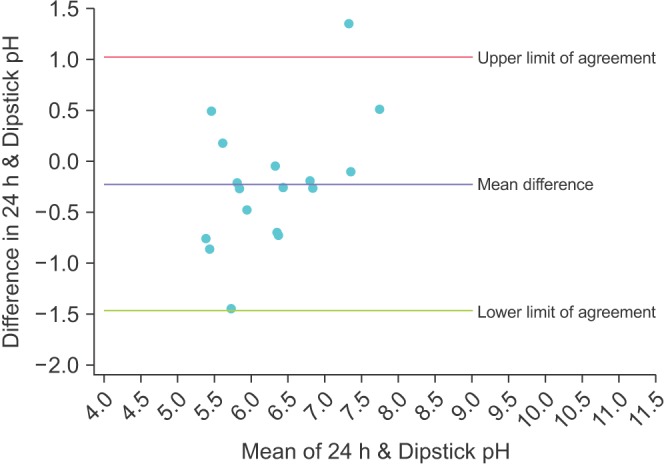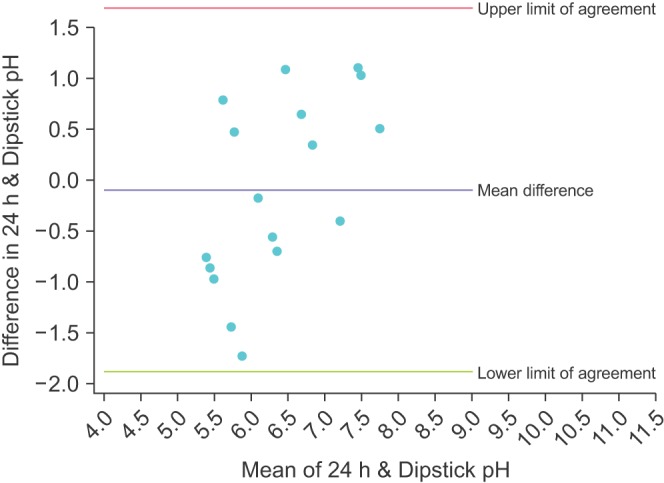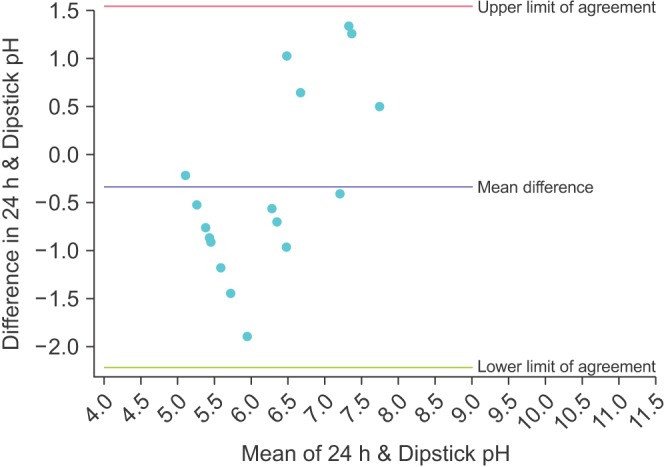Investig Clin Urol.
2017 Sep;58(5):378-382. 10.4111/icu.2017.58.5.378.
Optimization of urinary dipstick pH: Are multiple dipstick pH readings reliably comparable to commercial 24-hour urinary pH?
- Affiliations
-
- 1Division of Urology, Department of Surgery, University of California San Diego, San Diego, CA, USA. jabbott@cua.md
- 2Department of Urology, University of California Los Angeles, Los Angeles, CA, USA.
- KMID: 2388056
- DOI: http://doi.org/10.4111/icu.2017.58.5.378
Abstract
- PURPOSE
Accurate measurement of pH is necessary to guide medical management of nephrolithiasis. Urinary dipsticks offer a convenient method to measure pH, but prior studies have only assessed the accuracy of a single, spot dipstick. Given the known diurnal variation in pH, a single dipstick pH is unlikely to reflect the average daily urinary pH. Our goal was to determine whether multiple dipstick pH readings would be reliably comparable to pH from a 24-hour urine analysis.
MATERIALS AND METHODS
Kidney stone patients undergoing a 24-hour urine collection were enrolled and took images of dipsticks from their first 3 voids concurrently with the 24-hour collection. Images were sent to and read by a study investigator. The individual and mean pH from the dipsticks were compared to the 24-hour urine pH and considered to be accurate if the dipstick readings were within 0.5 of the 24-hour urine pH. The Bland-Altman test of agreement was used to further compare dipstick pH relative to 24-hour urine pH.
RESULTS
Fifty-nine percent of patients had mean urinary pH values within 0.5 pH units of their 24-hour urine pH. Bland-Altman analysis showed a mean difference between dipstick pH and 24-hour urine pH of -0.22, with an upper limit of agreement of 1.02 (95% confidence interval [CI], 0.45-1.59) and a lower limit of agreement of -1.47 (95% CI, -2.04 to -0.90).
CONCLUSIONS
We concluded that urinary dipstick based pH measurement lacks the precision required to guide medical management of nephrolithiasis and physicians should use 24-hour urine analysis to base their metabolic therapy.
MeSH Terms
Figure
Reference
-
1. Rule AD, Lieske JC, Li X, Melton LJ 3rd, Krambeck AE, Bergstralh EJ. The ROKS nomogram for predicting a second symptomatic stone episode. J Am Soc Nephrol. 2014; 25:2878–2886. PMID: 25104803.
Article2. Kang HW, Seo SP, Kwon WA, Woo SH, Kim WT, Kim YJ, et al. Distinct metabolic characteristics and risk of stone recurrence in patients with multiple stones at the first-time presentation. Urology. 2014; 84:274–278. PMID: 24768010.
Article3. Pearle MS, Goldfarb DS, Assimos DG, Curhan G, Denu-Ciocca CJ, Matlaga BR, et al. Medical management of kidney stones: AUA guideline. J Urol. 2014; 192:316–324. PMID: 24857648.
Article4. Kwong T, Robinson C, Spencer D, Wiseman OJ, Karet Frankl FE. Accuracy of urine pH testing in a regional metabolic renal clinic: is the dipstick accurate enough? Urolithiasis. 2013; 41:129–132. PMID: 23435644.
Article5. Strohmaier WL, Hoelz KJ, Bichler KH. Spot urine samples for the metabolic evaluation of urolithiasis patients. Eur Urol. 1997; 32:294–300. PMID: 9358216.6. Murayama T, Sakai N, Yamada T, Takano T. Role of the diurnal variation of urinary pH and urinary calcium in urolithiasis: a study in outpatients. Int J Urol. 2001; 8:525–531. PMID: 11737477.
Article7. Murayama T, Taguchi H. The role of the diurnal variation of urinary pH in determining stone compositions. J Urol. 1993; 150(5 Pt 1):1437–1439. PMID: 8411418.
Article8. Desai RA, Assimos DG. Accuracy of urinary dipstick testing for pH manipulation therapy. J Endourol. 2008; 22:1367–1370. PMID: 18578664.
Article
- Full Text Links
- Actions
-
Cited
- CITED
-
- Close
- Share
- Similar articles
-
- Urinalysis: The Usefulness and Limitations of Urine Dipstick Testing
- Measurement of urinary protein in children
- Diagnostic value of dipstick urinalysis as a screening test for urinary tract infection
- Usefulness of Urinary Trypsinogen-2 Dipstick Test for Diagnosis of Acute Pancreatitis
- Significance of urine dipstick in the evaluation of hematuria in patient with renal trauma





